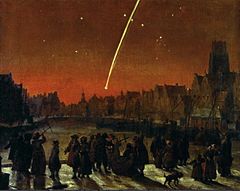- Great Comet of 1680
-
C/1680 V1 
The Great Comet of 1680 over RotterdamDiscovery Discovered by: Gottfried Kirch Discovery date: 1680-11-14 Alternate designations: Great Comet of 1680, 1680 V1 Orbital characteristics A Epoch: 1680-Nov-29.0
2335000.5(?)Aphelion distance: 889 AU Perihelion distance: 0.00622 AU[1][2] Semi-major axis: 444 AU Eccentricity: 0.999986[1][2] Orbital period: ~10,000 yr[3] Inclination: 60.7° Last perihelion: 1680-12-18[1][2] Next perihelion: unknown C/1680 V1, also called the Great Comet of 1680, Kirch's Comet, and Newton's Comet, has the distinction of being the first comet discovered by telescope. Discovered by Gottfried Kirch on 14 November 1680, New Style, it became one of the brightest comets of the 17th century--reputedly visible even in daytime--and was noted for its spectacularly long tail.[4] Passing only 0.42 AUs from Earth on 30 November,[5] it sped around an incredibly close perihelion of 0.0062 AU (930,000 km; 580,000 mi) on 18 December 1680, reaching its peak brightness on 29 December as it rushed outward again.[2][5] It was last observed on 19 March 1681.[1] As of December 2010[update] the comet was about 253 AU from the Sun.[6][7]
While the Kirch Comet of 1680-1681 was discovered and subsequently named for Gottfried Kirch, credit must also be given to the Jesuit, Eusebio Kino, who charted the comet’s course. During his delayed departure for Mexico, Kino began his observations of the comet in Cadíz in late 1680. Upon his arrival in Mexico City, he published his Exposisión astronómica de el [sic] cometa (Mexico City, 1681) in which he presented his findings. Kino’s Exposisión astronómica is among one of the earliest scientific treatises published by a European in the New World.[8]
Although it was an undeniably a sungrazing comet, it was probably not part of the Kreutz family.[9] Aside from its brilliance, it is probably most noted for being used by Isaac Newton to test and verify Kepler's laws.
References
- ^ a b c d "JPL Small-Body Database Browser: C/1680 V1". Jet Propulsion Laboratory. 1681-03-19 last obs (Encke : 125 day data arc). http://ssd.jpl.nasa.gov/sbdb.cgi?sstr=C/1680+V1. Retrieved 2011-07-26.
- ^ a b c d "JPL DASTCOM Comet Orbital Elements". http://ssd.jpl.nasa.gov/data/ELEMENTS.COMET. Retrieved 2010-02-10. "Num Name ... q ... Tp ... C/1680 V1 (1680 V1) ... 0.00622200 ... 16801218.48760"
- ^ Horizons output. "Barycentric Osculating Orbital Elements for Comet C/1680 V1". http://ssd.jpl.nasa.gov/horizons.cgi?find_body=1&body_group=sb&sstr=C/1680+V1. Retrieved 2011-07-26. (Solution using the Solar System Barycenter and barycentric coordinates. Select Ephemeris Type:Elements and Center:@0)
- ^ James W. Werner. "The Great Comet of 1680". http://home.att.net/~jwwerner51/Comet.html. Retrieved 2006-02-05.
- ^ a b Donald Yeomans. "Great Comets in History". Jet Propulsion Laboratory/California Institute of Technology (Solar System Dynamics). http://ssd.jpl.nasa.gov/?great_comets. Retrieved 2007-08-01.
- ^ NASA. JPL Small-body database browser approximate orbit plot. (needs Java)
- ^ NASA. JPL HORIZONS ephemeris more accurate position, no plot.
- ^ H. E. BOLTON. Kino’s Historical Memoir of the Pimería Alta. Cleveland, OH (USA): Arthur H. Clark, 1919. Reprint 1949.
- ^ Tony Hoffman. "A SOHO and Sungrazing Comet FAQ". http://home.earthlink.net/~tonyhoffman/SOHOfaq.htm. Retrieved 2006-02-06.
Categories:- Comets
- 1680 in science
Wikimedia Foundation. 2010.
